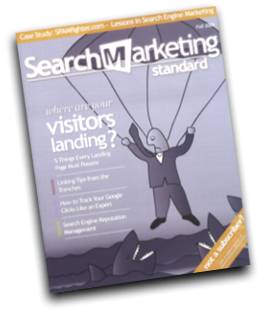Tuesday, August 22, 2006
Search Marketing Standard (Review)

I received a review copy of Search Marketing Standard (the Fall issue). The magazine’s quite nice. It focuses on search engine optimization techniques, expert interviews, landing page optimization (e.g. A/B split tests), URL rewriting with programming examples and such. Articles are easy to read, without artificial “verboseness” to fill the pages. The overall philosophy of the magazine is clearly white-hat, a good thing to see.
The table of contents from this issue is:
- Where are your visitors landing? 5 things every landing page must possess (Kevin Gold)
- Linking tips from the trenches (Eric Ward)
- Risky SEO techniques (Tyson Kirksey)
- Interview with Nick Usborne (Andrey Milyan)
- Product review – The Search Engine Marketing Kit
- How to track your Google clicks like an expert (Bryan Todd)
- Case study – Spamfighter.com: Lessons in Search Engine Marketing (with Martin Thorborg)
- Google launches Co-op (Tom Dahm)
- Getting your click fraud refund (Greg Laptevsky)
- Creating provocative URLs with “mod_rewrite” (Jaimie Sirovich)
- Search engine reputation management (Kent Lewis)
- Calendar of events
If you’re already an SEO expert, much of the advice won’t be new to you, but it’s a great overview for those starting out with SEO, or those experts still trying to expand their horizon.
I found a couple of things that were new to me, albeit admittedly, most of what can be said about Google’s internal workings is just guesswork. Take for example this bit by Martin Thorborg:
Pay for your domain name for 10 years in advance. This shows you plan to be in business a long time and will get you a higher rank in Google.
Sounds interesting, but I’d like to see proof for that.
There were also some minor errors (it’s “alt attribute”, not “alt tag”, as Tyson Kirksey puts it) as well as stuff that can be easily misunderstood. For example, Eric Ward suggests:
Links that are older, originate from top-level domains (”.edu”, “.gov”) and those that appear on certain “trusted” content sites have a greater link value.
Compare this to what Matt Cutts said earlier this month:
Somebody else asked about links from .gov’s and .edu’s, and whether links from two level deep .gov’s and .edu’s (like gov.pl), are worth the same as .gov. And the fact is, we don’t really have much in the way to say, this is a link from the ODP, or from .gov, or .edu, to give that some sort of special boost. It’s just those sites tend to have higher PageRank, because more people link to them (and reputable people link to them).
One problem with the magazine is that it’s not always easy to tell apart the content from the ads. They were designed quite similar without disclosures, whereas in mags like Wired, I always find the two easy to tell apart.
As much of this issue reads like a general overview and guide, I wonder if the makers will be able to find new content for each issue. It might be nice to see more case studies (and possibly, more numbers – I was curious to see how much money those guys make with their different optimized websites). Or a couple of web promotion techniques that don’t rely on search. But all in all, the mag is off to a good start. I guess like a good website they’ll work with the reader feedback they get to improve future issues, so let’s see how they evolve.
>> More posts
Advertisement
This site unofficially covers Google™ and more with some rights reserved. Join our forum!
